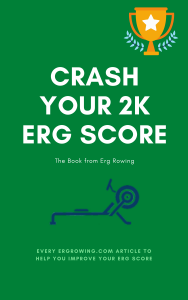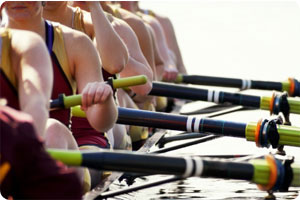You need to have a good rowing catch for lots of reasons. Most rowers get it right and are capable of working an excellent catch at the beginning of the rowing stroke.
But whether you row on a daily or weekly basis, on the erg or in the boat, you should always aim to have a great rowing catch to get the most out of your rowing training sessions. Here’s how you can do it.
# 1 Sit At The Right Angle
Make sure you sit up relatively straight at the catch position. Don’t be in a position where you are reaching forward too far from your hips or shoulders because this will cause a weakness in your set up and rowing timing.
And it could lead to other technical problems during the power phase.
The correct angle that you should aim to be at with your body at the rowing catch should be a pitch forward at about 1 or 2 o clock. Anything more than this will be over reaching and will cause you to work harder than you need to when you are opening up your body on the drive phase.
On the other hand if you are too upright (or even leaning back – which is a big NO NO) then you will not be able to fully utilise your body swing angle towards the finish of the drive phase.
If your shoulders are too far out of your sockets it will cause a rowing catch that is taken mainly by your shoulders. It could also cause problems in the rowing power phase just like the wrong body angle will.
#2 Catch The Flywheel
The perfect rowing stroke catch for you involves putting yourself in a position of maximum strength and bracing capability. If you are outside the zones of optimum position your catch will be either too weak or too hard.
A weak catch will force you to row harder late in the drive phase. It’s easy to spot a rower with a weak catch – they usually look a little slow in the first part of the drive (especially with the legs) and have a big whooosh rowing finish to compensate for the lack of power at the catch.
A hard rowing catch is not the best way to begin the rowing stroke either because you are risking loading your lower back and shoulders in a way that would risk injuring yourself. It’s not worth it.
The best rowing catch involves a little brain power.If you think about the word ‘catch’ for a second you will realise that it means to catch … i.e. you are not hitting, banging, lifting, pulling, connecting, reversing…
You are simply… catching.
Catch the flywheel on the fly, tip it along and keep it going, don’t slow it down or try to move the flywheel faster than the rest of the rowing stroke can take.
Just think ‘catch’, same as you you’d catch a ball in mid-air – with skill and definite poise.
# 3 You Need to Brace
The bracing of the load of the handle through your body and on to your legs is crucial. The seat on the rowing erg or in the boat is merely a balancing object – it has nothing to do with power.
It’s only useful to maintain your balance vertically on the drive phase and a good place to rest and relax your legs on the recovery phase.
All the power in rowing is anchored between the handle and your feet. You are pushing one off the other. And to do it correctly in the right rowing sequence, you need to begin correctly – at the catch.
If you don’t brace yourself correctly the transfer of power from your feet to your handle you will never be fully effective of efficient.
Think about engaging your big muscles in a good order and sequence (legs, back, arms). Once you catch, brace your arms and back while your legs do the job. Then and only then should you allow the brace position of your arms and legs to change (in the back swing) through the rowing sweet spot and towards the finish.
[mc4wp_form]



February 19, 2011 at 3:44 pm
Good advice – but you can’t talk about the “correct angle” at the catch without talking about the rest of the recovery. The last thing into the catch will be the last thing out. If the rower lunges to “2 o’clock” at the catch, which I agree is the ideal catch angle, then the back will be the first thing out. 2 o’clock needs to be set at the release, and held firm into the catch… the legs will be the last things into the catch, and then the first thing out.
I’m sure I’m saying what you already know but it wasn’t mentioned in the article, and I don’t think it’s possible to talk about the angle at the catch without talking about how to set it. 🙂
March 27, 2013 at 11:37 am
Excellent advise here, however you have failed to mention arguabley one of the most important aspects of the catch, the correct movement.
The catch should, when in the correct position, be maneuvered through an upwards lift of the wrists, originated through the thumbs. It is key to also maintain relaxation in the shoulders, so the upwards wrist movement places the blade in the water and allows the outside arm to have optimum connection with the gluteus on the drive.
Im sure you already know why im talking about but it is hard to talk about the catch without including how to actually place the blade in!
Regards,
James
October 20, 2020 at 5:01 am
I suggest you approach the catch with relaxed arms, with perhaps 10′ at the elbow. As you slow for the catch the blade momentum straightens the arms. Square the blade as this happens, and at full stretch of the arms drop the spoon in the water. As this happens swivel above the hips to lay back about 10′, then start straightening the legs. The arms remain nearly straight until the legs are about 2/3 down, when they then pull the blade to touch the torso. The legs finally straighten when the hands reach torso, and immediately rebound, as do the hands. The hands push the blade away fast to clear the rising knees. No pausing anywhere. Also use 1:1 in:out, 2 breaths per stroke, and a relaxed,evenly curved back. Feather while the blade is leaving the water, but don’t lift water – push it.
This method – the ‘Rhecon’ style, Reduces the load on the back, and makes holding the legs down unnecessary.
Have fun!